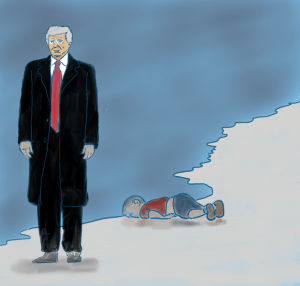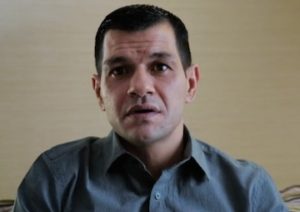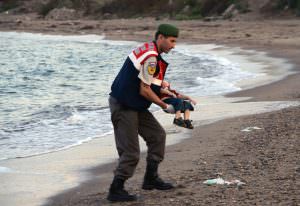As Immigrant Deaths Pile Up, We Need to Find Our Moral Compass
Now’s the time—actually, well past time—to push back against Trump’s inhumane immigration policies. Rosa Ramirez cries when shown photographs of her son, Oscar Alberto Martinez Ramírez, her granddaughter Valeria and her daughter-in-law Tania Vanessa Avalos while speaking to journalists at her home in El Salvador on Tuesday. (Antonio Valladares / AP)
Rosa Ramirez cries when shown photographs of her son, Oscar Alberto Martinez Ramírez, her granddaughter Valeria and her daughter-in-law Tania Vanessa Avalos while speaking to journalists at her home in El Salvador on Tuesday. (Antonio Valladares / AP)
Nearly four years ago, the devastating photos of a Syrian toddler named Alan Kurdi, whose little body had washed ashore in Turkey, shocked the world. Kurdi’s story was tragically typical—his family had fled the Syrian war and attempted to cross the Mediterranean to seek refuge in Greece. All of Kurdi’s siblings and his mother died while crossing. Only his father survived.
Today, the photo of the bodies of Oscar Alberto Martínez and his two-year-old daughter, Angie Valeria, who drowned on the U.S.-Mexico border while crossing the Rio Grande, offers a heartbreaking analogy to Kurdi’s story. The two Salvadorans were forced to wait in Mexico, as per President Donald Trump’s demand, after they escaped their home country to try to seek asylum in the U.S.
Just as artists, activists and politicians the world over memorialized Kurdi’s death as a reminder of the injustice of the Syrian war and the barriers facing refugees, the deaths of Martinez and Valeria ought to serve as a reminder of the humanitarian catastrophes unfolding in Central America and driving large numbers of refugees northward.
Immigrants, including children, are suffering abuse and death on all sides of this battle for migration, and at nearly every step their harsh treatment is attributable to U.S. policies. The violence in their countries that is spurring northward migration stems from U.S. intervention in Central America. Coups such as the 1954 ousting of democratically elected Jacobo Árbenz in Guatemala, as well as the removal only ten years ago of President Manuel Zelaya in Honduras, are a signature part of Washington’s policies. Writing in the Guardian, reporter Julian Borger concluded, “The families in the migrant caravans trudging towards the US border are trying to escape a hell that the US has helped to create.”
Central American refugees are also facing abuse in Mexico, where the Trump administration has insisted that they be detained. An Associated Press report about Mexico’s largest detention center just north of its border with Guatemala found the facility to be “sorely overcrowded and filthy,” with “alleged repeated abusive treatment by agents tasked with running it.” Trump has threatened Mexico with harsh tariffs over the border crossings of Central Americans into the U.S. through Mexico.
Farther north, at the U.S.-Mexico border, deaths like those of Martinez and Valeria are a tragically routine occurrence. On the same day that the father and daughter perished, three young children and a 20-year-old woman were also found lifeless from what appeared to be dehydration and excessive heat. The Texas Civil Rights Project placed the blame for the border deaths squarely at the feet of the Trump administration, saying, “When the government creates policies that make it harder to cross the border safely, people die. Children die.”
And here in the U.S., conditions facing immigrant detainees, particularly children, have made headlines in recent days with disturbing reports from Border Patrol facilities in Clint, Texas, which told of “dangerous overcrowding” and a total lack of access to basic hygiene for children as young as one year old. Children remained locked in cages, suffered from the flu with no treatment, and older children were tasked with caring for younger ones in what can only be described as a “concentration camp” environment. Although the children were moved out of the facility after the outcry, about 100 were relocated back to the same facility just days later. Another detention center, in Calexico, Calif., was found to be operating in a similarly dangerous fashion. In May, reports emerged of migrants needing medical attention being shackled while receiving treatment. So far, at least seven children have died in U.S. custody.
For those who remain outside of U.S. custody, the looming threat of deportation raids at Trump’s behest by the dreaded Immigration and Customs Enforcement (ICE) agency has generated mass fear.
There are countless historical analogies of Trump’s persecution of immigrants. Trump has used language reminiscent of Nazi Germany in that regime’s pogrom against Jews in claiming that the U.S. “is full,” and that there is no room for immigrants. His administration has detained immigrants in the same facility in Oklahoma that once housed 700 people of Japanese origin during World War II. In fact, a year before the 2016 election, Trump could not even bring himself to denounce the internment of 100,000 Japanese, saying in a 2015 interview, “I would have had to be there at the time to tell you, to give you a proper answer.”
Rather than take clear moral positions against the appalling mistreatment of immigrants, some of Trump’s supporters have decided to engage in semantics to insist that there are no concentration camps in the U.S. They understand the power of language to reflect on past horrors. For example, Washington Post columnist Richard Cohen maintains that because Trump’s camps are not filling with the “screams of the dying,” they do not deserve the term “concentration camps.”
While the president and his supporters clearly lack the moral compass to recognize the abuse of human beings as wrong, much of the rest of the nation does not. Anna Lind-Guzik, writing in Vox, said, “I’m a Jewish historian. Yes, we should call border detention centers ‘concentration camps.’ ” She added, “It isn’t just accurate. It’s necessary.”
Some politicians have also taken a clear stand. Congresswoman Alexandria Ocasio-Cortez used the term “concentration camps” to describe detention centers in mid-June and came under intense fire for it. Democratic presidential candidates such as Sen. Elizabeth Warren, while gearing up for a debate in Miami this week, visited a nearby detention center in Homestead, calling attention to Trump’s cruelty toward immigrants. Others, like former Texas congressman Beto O’Rourke, responded to the photo of Martinez and Valeria’s lifeless bodies by saying unequivocally, “Trump is responsible for these deaths.”
Meanwhile, employees of the online furniture seller Wayfair are protesting their company’s decision to fulfill orders for detention centers holding migrants. One employee said to the press, “We’re walking out in protest of our leadership’s decision to sell to reprehensible concentration camps. … We want to make it clear that this is not a political issue—it’s a humanitarian issue, and we will not back down.” In using the term “concentration camps,” the workers are showcasing their humanity and their unequivocal stand on the side of morality.
Even Ravelry, a popular online knitting and crocheting website that I have used, has taken a stand. In a statement, the website eloquently and clearly explained which side it was on, saying, “We cannot provide a space that is inclusive of all and also allow support for open white supremacy. Support of the Trump administration is undeniably support for white supremacy.”
To Trump and his supporters, immigrants are not human. Dehumanization is the first step toward exclusion, persecution and mass abuse. America needs to embrace Ravelry’s courage to articulate that white supremacy and Trump are no longer welcome and that there is no room in America for fascism.
Your support is crucial…With an uncertain future and a new administration casting doubt on press freedoms, the danger is clear: The truth is at risk.
Now is the time to give. Your tax-deductible support allows us to dig deeper, delivering fearless investigative reporting and analysis that exposes what’s really happening — without compromise.
Stand with our courageous journalists. Donate today to protect a free press, uphold democracy and unearth untold stories.








You need to be a supporter to comment.
There are currently no responses to this article.
Be the first to respond.